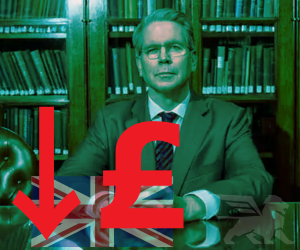A currency is the unit of money used to price and settle trades. Understand roles, codes, and how currencies function in forex. Learn the basics fast.
SCOTT BESSENT, TOP FX TRADER: HOW HE DEFEATED THE UK STERLING
This is a real, data-driven account of Scott Bessent’s ascent from Yale graduate to a leading member of George Soros’s London team, the group that famously shorted the pound sterling in 1992. We explain how the ERM’s rigid rules, Germany’s high rates, and Britain’s weak growth set up an asymmetric trade; how execution across banks, forwards and options amplified the move; and how risk control—not bravado—kept the position solvent while the Bank of England fired its volleys. We then track Bessent through subsequent macro campaigns and into Key Square, before concluding with how that trader’s discipline translates into his present-day stewardship in public office. It’s the craft, not the legend—told plainly, with lessons you can use.

From Yale to Soros: London, ERM and a thesis
Scott Bessent’s path into macro began with the basics: curiosity about how policy, prices and positioning interact. After an early start in research and equity short-selling, he moved into global macro and joined George Soros’s organisation at the start of the 1990s. London was the nerve centre for currency ideas because it sat between Asia’s close and New York’s open; it was also the right vantage point to study Europe’s fixed-but-fragile Exchange Rate Mechanism (ERM), where national currencies were pledged to stay within narrow bands against the Deutsche Mark. To an analyst trained to seek stress points, the ERM looked less like a system and more like a set of incentives waiting to be tested.
Bessent’s working style was thesis-first, then structure. A thesis had to be explicit: “If policy A collides with fundamentals B, then price C must adjust.” Structure meant building the exposure that fit the thesis rather than forcing the thesis into a convenient instrument. That approach discouraged hero trades and rewarded patience. On sterling, the thesis emerged from months of deskwork: rising German rates after reunification, Britain’s soft growth and sticky inflation, and a band defence that required ever-larger interventions as the domestic economy weakened. The implication was stark—either the UK would endure punishing rates and a deep downturn to defend the peg, or it would leave the ERM. Either way, sterling was overpriced.
The London team’s pre-mortems measured what could go wrong: what if the Bundesbank cut? What if fiscal policy tightened abruptly? What if concerted intervention overwhelmed short sellers? They mapped the policy calendar, the timing of central bank meetings, and the mechanics of the Bank of England’s defence. They also studied counterparties: which banks warehoused risk, which quickly laid it off, and which hinted—through quotes and timing—when official bids were hitting the market.
From an execution perspective, Bessent treated spot, forwards and options as parts of one machine. Spot carried immediacy and liquidity; forwards locked in carry and funding effects; options created convexity for binary moments. The desk combined them based on where policy pressure would likely peak. If authorities intervened aggressively, spot might squeeze but options would pay; if the defence ran out of reserves, forwards and spot would do the heavy lifting. The point was not to predict the minute of capitulation, but to survive long enough—and cheaply enough—to be there when it came.
By the summer of 1992, the team’s conviction was set, but the sizing remained disciplined. The market would get a vote every day; the job was to keep risk alive until fundamentals and policy reality converged. That mentality—curate exposures, don’t worship them—would become a Bessent hallmark.
Black Wednesday: Positioning, risk and execution
The run-up to 16 September 1992 was a clinic in asymmetry. Britain had committed to holding sterling within a tight ERM band; yet domestic conditions were poor. The defence required not just belief, but ever-higher interest rates and persistent central-bank purchases of sterling. For macro traders, that created a one-way incentive: if the peg held, they might lose carry and a few per cent; if it broke, they could gain multiples. Bessent, a leading member of Soros’s London team, specialised in turning that asymmetry into a portfolio that could absorb squeezes and still be there for the break.
Execution was meticulous. Orders were sliced across time zones and dealers to avoid obvious footprints. The book paired short-sterling exposure with multiple legs—versus the Deutsche Mark for ERM stress purity, versus the dollar for liquidity —and offered options to cover gap risk around policy announcements. The desk watched for signs of official bids: sudden tight spreads in otherwise jumpy moments, silent screens followed by block prints, or banks quoting two-way prices with unusual patience. Those told them the defence was in motion and helped time fresh sells into the flow.
When London awoke on Black Wednesday, the government escalated—first with aggressive interventions, then with a surprise rate hike, and later with a signal that even higher rates were possible. For a few hours, the squeeze was real. That is where risk systems mattered more than bravado. Bessent’s sizing rules, time stops, and option overlays kept the book solvent through the whipsaws. Once the market realised the defence was exhausting reserves and credibility, sterling’s path turned. The exit was orderly: scale out, avoid the temptation to call the exact low, and keep a residual position to capture aftershocks as the new regime priced in.
The post-mortem was as important as the profit. Why did it work? Not because traders “broke” a currency by themselves, but because a policy framework collided with fundamentals. Why did the sizing survive? Because the team respected liquidity and built convexity around binaries. Why didn’t they overstay? Because the thesis ended when the peg ended, clinging to the trade would have turned discipline into dogma. These are the parts of the story professionals focus on, long after the headlines fade.
For aspiring macro desks, the sterling episode is a template: study the regime, price the incentives, and build a structure that survives official resistance. Don’t aim to be a legend; aim to be still trading when the regime gives way. That was the difference between a story told and a career compounded.
The lesson is humble: macro is less about calling tops and bottoms and more about building trades whose worst-case is survivable. Bessent’s sterling chapter cemented that habit—and it would surface again in future campaigns.
From fund to Treasury: What the trader kept in the office
After sterling, Bessent’s career widened. He ran money through crises and calm, left the Soros organisation to manage his own capital, returned to take senior roles in macro, and eventually founded Key Square, a global macro firm that blended political analysis with hard data. The signatures remained: write the thesis before the trade, size by realised volatility, use options where the calendar could ambush you, and exit when the regime changes. Those rules are banal on the page and priceless in practice. They are why a handful of big trades didn’t define the career—process did.
Colleagues recall a desk run like a newsroom: open debate, facts first, and a ban on euphemism. If a position was wrong, the right adjective was “wrong,” not “early.” If liquidity was poor, the right noun was “risk,” not “opportunity.” That culture made room for creativity within guardrails. When the trade was carry, the book respected the grind; when the trade was regime shift, the book hired convexity. Where others chased noise, the desk chased sequencing: get the order of events right, and the rest takes care of itself.
The bridge from hedge fund to public office came later, but the method translated. As Secretary, he has no lever to set short rates—that’s a central bank’s job—but he does oversee the plumbing that connects policy to markets: issuance mix, buyback pilots, the cadence of refunding announcements, the clarity of sanctions design, and the international conversations that signal where capital will flow. The trader’s habit of publishing a scorecard—objectives, metrics, and what would force a pivot—turns into a public service. Markets price what they can see; ambiguity widens, spreads, and discourages investment.
The concluding idea is simple and new only in its honesty: treat policy the way a professional treats risk—as a distribution, not a decree. Publish the base case, upside and downside; explain the conditions that would move weight across them; and keep your word when those conditions arrive. In trading, that mindset keeps you solvent. In government, it keeps you credible. Bessent’s record in FX taught that lesson early; his work since has been about applying it, quietly and repeatedly, wherever the stakes are highest.
In the end, the “attack on the pound” was not vandalism; it was a stress test of a policy promise that couldn’t withstand arithmetic. Scott Bessent’s part in that story was to recognise the arithmetic early, express the view precisely, and manage risk so that price could do the talking. That is the through-line from desk to department, and it is why his FX career reads more like a manual than a legend.
YOU MAY ALSO BE INTERESTED









